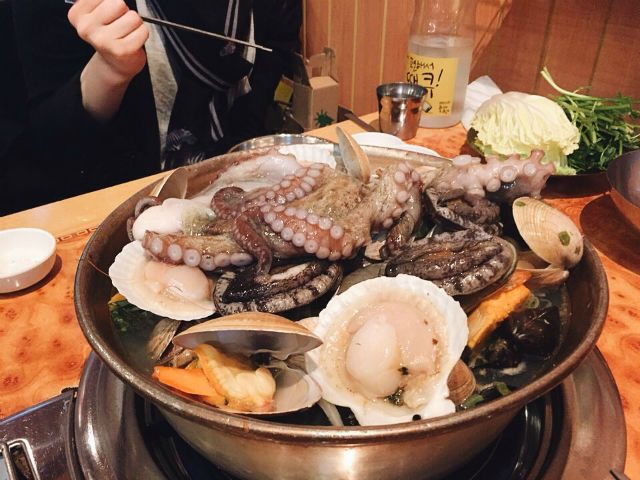SUMMARY
This is AI generated summarization, which may have errors. For context, always refer to the full article.

MANILA, PHILIPPINES – It’s common sense: Nobody knows Korean food like the Koreans themselves. I’ve been to South Korea 6 times, always planning a meticulous itinerary, but each time I return home, I realize my favorite meals are rarely the ones I planned for myself. They’re the restaurants, teahouses, and mom-and-pop shops that my friends in Seoul pick out for our reunion dinners.
Here are some of their recommendations.
Knife-cut noodles and dumplings at 명동 교자 (Myeongdong Kyoja)
Established in 1966, the family-owned chain has attracted a steady stream of tourists over the years, which has only gotten more intense after they were awarded a Bib Gourmand in the 2017 Michelin Guide. But despite the fanfare, Myeongdong Kyoja retains its credibility among locals because everything from the noodles to the dumpling wrappers to the garlic-heavy kimchi is made in-house. Jin, the guy I call my Korean big brother, texted me the address and his one request: Come early so we avoid the line.
We ordered Jin’s favorites: bowls of kalguksu: knife-cut noodles in thick chicken broth and a shared serving of dumplings made with top-grade pork, leeks and fresh sesame oil, covered in a silky, translucent wrapper. It’s great for a cold day but during the summer months, Jin says you should try the kongguksu, a cold bean noodle soup topped with sesame and cucumber.
Budget: KRW12,000-20,000 per person
Location: Two branches in Myeongdong. Map and subway directions here.
Traditional teas at 달새는달만생각한다 (Dalsaeneun Dalman Saenggakhanda)
Its name is a mouthful in any language – it translates to “The Moonbird Does Think of Only the Moon” – so many know this teahouse simply as “Dalsae” or “Moon Bird.” If you’re the type of traveler who finds that poetic, you’ll be charmed by everything in Moon Bird.
We discovered this teahouse after it was featured on a walking tour organized by Seoul residents. Blink and you’ll miss the quiet alley off the louder, touristy side of Insadong leading to this teahouse.
An unassuming green door opens into a small, rustic home decorated with the lifeblood of Korean teas: dried corn hanging from the walls, glass jars filled with jujube and flowers, and barley in woven baskets. Your tea comes in a large mug paired with a selection of traditional sweets like red bean-filled rice cakes and chewy cookies made from puffed grains.
The walls are covered with messages from happy customers; Korean couples on dates signing their names inside hearts is a popular theme. Don’t forget to leave your own personalized message on the way out.
Budget: KRW6,000-9,o00
Location: Just off the main street of Insadong, near Anguk Station. Map here.
Seafood Heaven Hotpot at 삼원 해천탕 (Samwon Haecheontang)
My friend Yujin grew up in the neighborhood of Oksu, where this mom-and-pop shop is located. It used to be middle-class area, she said, until developers started buying out residents to build high-rise condominiums. The restaurant is one of the holdovers from the old days and is so popular that it isn’t going anywhere anytime soon.
The name of this mom-and-pop shop translates to “seafood heaven stew,” which, I gotta tell you, is pretty accurate. The set that is good for one (KRW15,000), comes with scallops, mussels, clams, shrimps, and your choice of small nakji octopus or abalone. From here, you can add on extra seafood, thinly sliced beef for shabu-shabu and more. The set for four (KRW 90,000) has the works, including a large muneo octopus and a whole chicken cooking at the bottom of the pot.
Budget:
Good for 1 (scallops, mussels, clams, shrimps, choice of nakji octopus or abalone) – KRW15,000
Good for 2 (scallops, mussels, clams, shrimps, nakji octopus and abalone) – KRW30,000
Good for 3 (whole chicken, scallops, mussels, clams, shrimps and abalone + sannakji octopus side dish) – KRW50,000
Good for 4 (live muneo octopus, whole chicken, scallops, mussels, clams, shrimps, and abalone) – KRW70,000
Side orders: Shabu-shabu cut Hanwoo beef (KRW8,000), sannakji live octopus (KRW25,000), Hanwoo beef tartare (KRW20,000)
Location: You can take the subway to Oksu station and from there, take a 10-minute taxi ride. Show this map.
Seasonal buffet and hotpot at 비비고 계걸 밥상 (Bibigo Gyejeol Bapsang)
If it’s your first time to try a new cuisine, buffets are a safe bet. For a single rate, you can try a bit of everything and decide what you like best later. I came across this restaurant while digging around Korean Instagram. Gyejeol Bapsang, or “Season’s Table,” has branches in touristy places like Insadong atop N Seoul Tower, and even the Incheon International Airport; but when we went there, majority of the diners were locals.
Everyone lined up for the usual favorites – a ssam bap station for your meat-and-lettuce wraps, a make-your-own bibimbap station, crunchy deep-fried dumplings, and green tea desserts. But I suggest being a bit adventurous and trying the featured regional and seasonal dishes like cold noodles topped with assorted vegetables and a tangy, mildly spicy sauce. If they have them in season, don’t pass up the frozen persimmon for dessert! More importantly: for a minimal added fee, you can have a hot pot in the middle of your table with unlimited sliced beef. (Do it.)
Plus points for this restaurant being English-friendly! All dishes are labeled in both Korean and English, and the staff at the Insadong branch speak different languages to explain the hotpot and pricing once you sit down. It’s best to come during weekdays, because it tends to be crowded on Fridays and weekends.
Budget: KRW19,000-25,000 per person
Location: B1 – Insadong Maru, along the main street of Insadong. Map here – the orange pin on the map is the Anguk Subway Station. – Rappler.com

Ceej Tantengco is an NCAA courtside reporter, television producer, and 3-time Palanca Award-winning essayist. As an advocate for gender equality in sports media, she visits schools to discuss how to create better environments for female athletes and female sports journalists alike. Follow her on Twitter, Facebook, and Instagram.
Annyeong haseyo! Plan exciting activities for your Korea trip with Klook and save big!
Add a comment
How does this make you feel?
There are no comments yet. Add your comment to start the conversation.